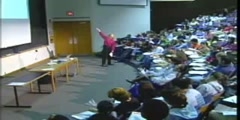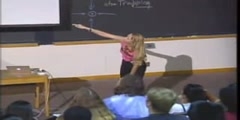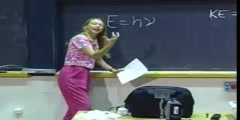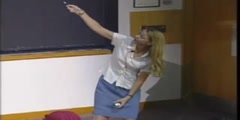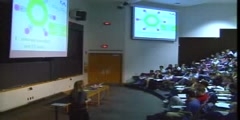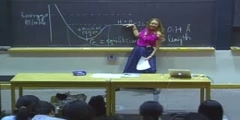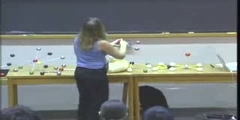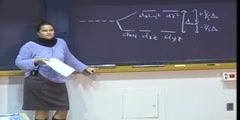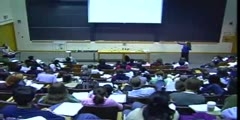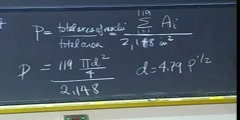Chemical Science - Wavelike Properties of Radiation - Lec 3
Principles of Chemical Science/n * Email this page/nVideo Lectures - Lecture 3/nTopics covered: /nWavelike Properties of Radiation/nInstructor: /nProf. Sylvia Ceyer/nTranscript - Lecture 3/nAll right. So by last Friday we discovered the electron, discovered the nucleus. And the problem then was how to describe the structure of the atom. They knew there was an electron, they knew there was a nucleus, but exactly how did the electron and the nucleus hang together? And we talked about how the scientists at that time proposed a classical model where the interaction between the electron and the nucleus was, of course, the Coulomb interaction, but where the equations of motion were Newton's equations of motion to describe this electron going around the nucleus, F = ma./nAnd, although we didn't show it, what we said was that if we used that force field, the Coulomb force, coupled with Newton's equations of motion. And, actually, you also have to couple them with some classical electromagnetism, which I may not have said but which isn't important./nBut if you use those classical ideas to describe how that electron goes around that nucleus, well, you would find that in 10-10 seconds that electron would be on top of the nucleus. And you would no longer have what we know to be the structure of the atom in the sense that you would no longer have some volume where the diameter of that volume is on the order of an angstrom or so./nThe bottom line is that classical ideas, classical mechanics and classical electromagnetism just totally fail to explain the structure of the atom. And that was the conundrum that the scientists faced in 1911./nThis was quite a big problem for the scientific community and was so for about 10, 12, 13 years. And, of course, what fails are the classical equations of motion, Newton's equations. A new kind of mechanics is going to have to be invented in order to understand how that atom is bound or how the electron and the nucleus are bond, how it's stable./nBut now, historically, the actual clues for why the electron didn't collapse into the nucleus. Those clues actually came from a very different area of discussion, and that area of discussion is this wave particle duality of light and matter./nIt was certainly long believed that matter, with its particle-like behavior, was distinct from light, which was this kind of transmission of energy through space. But in the late 1800s and early 1900s, there began to be made some observations that seemed to suggest that well, you know, maybe this boundary between matter and its particle-like behavior and light and its wave-like behavior wasn't so rigid after all./nAnd, in fact, what we're going to see is that radiation or light exhibits both wave-like behavior and particle-like behavior. And it depends on the kind of experiment that you do which one of those properties you see, and that consequently matter also exhibits both particle-like behavior and wave-like behavior./nAnd, again, it depends on the particular experiment that you do as to which one of those properties you actually observe. What we are going to do right now is we're actually going to set aside the discussion of the structure of the atom, how the electron and the nucleus are bound together, how in the world do they remain stable? We are going to set that discussion aside, and we are not going to pick it up until next Monday./nAnd the reason for it is because in order to proceed with that discussion, we actually have to go through this other set of observations, this discussion about the wave particle duality of light and matter in order to get the clues, in order for us to make progress about what next big leap we've got to make in order to talk about the structure of the atom./nWe are going to change subjects, or it's going to look like we're changing subjects, but we're going to use the results of our discussions in the next three days to come back to talk about the structure of the atom./nThen the first thing we've got to talk about is we're going to talk about light and we're going to talk about the wave-like nature to radiation. And since that is really probably most intuitive, let's do that./nProperties of waves. Well, what are waves? Well, you are familiar with that. Waves are a periodic variation of some quantity. In the case of water waves, we have the periodic variation of the height of water./nAt some points in space here, the height of the water is high, at some point the height of the water is low and there is some average level here. A sound wave. Well, a sound wave is a periodic variation of the density of air./nAt some points in space the air is very dense, at other points in space the air is not so dense, and then there is an average level here. Well, what we're going to do is we're going to set this average level here to a zero./nAnd then, consequently, our waves are going to have a positive amplitude that is measured from this zero level up. That's a positive amplitude. And measured from zero level down, that's our negative amplitude./nThese waves are going to have positive and negative amplitude. That is going to be very important in how they actually behave. Now, what we're going to do, oh, so what is light? Well, light is a periodic variation of an electric field./nAnd that is what I plot here. Electric field versus distance. And you can see it is varying in intensity. But what exactly is an electric field? Well, let's just think about that for a moment. Suppose I take two parallel plates, here is one and here is another, and I am going to put a negative potential on that top plate and a positive potential on the bottom plate./nAnd what is operating then between this negatively charged plate and the positively charged plate is the Coulomb interaction. And the electric field then is the space through which that Coulomb force operates./nSo, that electric field here is this space through which this Coulomb force is operating. And, by convention, we are going to say that it is operating here in this orientation. In other words, if I put a positive charge in between these two plates, in this electric field, this space through which the Coulomb force is operating, well, what's going to happen is that this positive charge is going to drift to the negatively charged plate./nBut if I turn the geometry around. If I put the negatively charged plate on the bottom using this coordinate system. And I now put that positive charge in that electric field. It's going to drift to the negatively charged plate again, but it's going to move in this coordinate system down./nSo, this electric field has not only magnitude, because you can imagine the larger the potential difference between these two plates the larger the magnitude of the electric field. But that electric field also has direction./nIt is pointed in one way or the other. And that is what represented here on my diagram of the electric field versus distance. You can see that right here the electric field, the magnitude of it starts out small, it increases, continues to increase until we get a maximum, and then it starts getting smaller./nIt gets smaller and goes all the way to zero at which point then it turns around and the magnitude begins to increase in the opposite direction. And, again, it becomes a maximum in the opposite direction and then turns around and goes to zero and continues./nSo, it's a periodic variation here of an electric field. And so what that means is that if we put some charge, say, at this point in space, it will be pulled one way. And if we put it at this point in space, it will be pulled yet another way./nAnd if we put it right here at zero, it's not going anywhere. Now, what I've shown you here is a periodic variation of an electric field. It is also the case that whenever we have an electric field, we also have a magnetic field that is actually perpendicular to this electric field here./nBut since that magnetic field is going to have all the same characteristics as the electric field, from our point of discussion here, I am not going to talk about it, but you are going to see this a lot next semester in 8.02./nSo, we are just going to characterize here the electric field. And the way we're going to characterize it is to put a functional form to it. I am plotting the electric field here as a function of X./nAnd the functional form that we are going to use to characterize it is Acos(2pX/?), a cosine function. Now, what I want you to notice is that this field oscillates between a positive amplitude A and a negative amplitude A, or a minus A./nThis coefficient right out in front, right here, that coefficient physically is the maximum amplitude. So, if you were to be given a waveform that has a number out here in front of a cosine X, that number, immediately the physical significance of it is that it's the maximum amplitude./nThe other parameter, besides the amplitude here, the maximum amplitude that we use to characterize this cosine function is the wavelength. The wavelength is the distance between two successive maxima or two successive minima./nAnd that wavelength here comes in the argument of that cosine function. Again, if you were to be given a form that had a number times cosine times a number times X, well, that number is equal to 2p/?./nAnd so almost by inspection you can figure out what the wavelength is just from the functional form of that cosine function. And because the argument is 2pX/?, well, you can easily see that you get the maximum amplitude A here whenever X is an integral multiple of lambda./nWhen X is ?, 2?, 3? or -?, -2? or 0. Most of that, I think, you're familiar with. But not only is light, or formally electromagnetic radiation, simply a periodic variation of the electric or magnetic field, but light is also a period variation in time./nThat is light propagates, it moves. For example, here is a cosine functional form at some snapshot in time, T = 0. And I put a star here on the maximum of one of these maxima. Now, what happens is that this wave moves./nIt propagates. And the time it takes that wave to move one wavelength, just like it did in that very short clip -- The time it takes to move one wavelength so that this maxima that was here is now there is what we call a period./nOne period is the time it takes the wave to move one wavelength. And we can also characterize the period by the frequency of the wave. That frequency is new here and the period is one over nu. And the frequency then is the number of cycles per second./nIn other words, if I were sitting right here at X = 0 and I am just watching the wave come by me, the frequency is the number of times that a maxima passes by me per second or the number of times a minima passes by me per second./nThat is the frequency. I will make that a little bit more obvious in just a moment. Frequency, I said, is the number of cycles per second. But the unit that we use to convey frequency in something called the hertz, hz./nAnd formally it is just inverse seconds. We drop the number of cycles, but the number of cycles in that unit is implied. Now suppose the following. I said that this electric field has magnitude and it also has direction./nSuppose I take an electric field or an electromagnetic radiation that has a frequency of 1 hz, one cycle per second. And right here at X = 0, somehow I pin an electron right there. It cannot move anywhere./nIt's just stuck. What is going to happen to that electron as this radiation of 1 hz passes by? Well, what's going to happen is that that electron, since it's starting at the top, is going to be pulled down./nAnd then it is going to be pushed back up to its original position every one second because this frequency here is 1 hz and because this electric field has both magnitude and it has direction. Now we're going to let this electric field go by, the electron gets pushed down and pulled back up once every second./nHopefully that makes the idea of frequency a little bit more real to you. Not only do we have this periodic variation in time, but we also have the wave propagate here in space. That wave moves this way or this way or this way./nAnd so what we want to know is the speed of that propagation. Now, speed is always distance traveled over the time elapsed. And what we have already seen is that this wave will move by one wavelength in the time period of a period./nThat is we already saw that this wave will move here one wavelength, from here to here, in the time period of a period or one over new. That's the time elapsed. So, the speed of this propagation, the speed with which it's moving is the distance traveled, which is lambda, divided by the time elapsed, which is one over nu./nAnd, therefore, the speed of that propagation is lambda times nu. These are the important concepts here. We have the speed of the propagation, lambda times nu, we characterized our wave in terms of amplitudes, in terms of wavelengths and in terms of frequency./nThose are the quantities that are important that you really do have to understand very well. Now, I think that you are all familiar with the fact that all electromagnetic radiation has a constant speed./nThat is the wavelength of electromagnetic radiation times the frequency is always equal to this number. It's about 3 x 108 meters per second. And we abbreviate it C, the speed of light. No matter what frequency you have of radiation, the corresponding wavelength is such that the wavelength times the frequency is this constant, is this value of C./nAnd, of course, it is the different frequencies or the different wavelengths of electromagnetic radiation that gives it its different characters. Even though it all has the same speed of propagation./nAnd those different kinds of properties, so to speak, are this spectrum of electromagnetic radiation. So, electromagnetic radiation is an infinitely wide spectrum. At very long wavelengths we have what are known as radio waves./nAt very short wavelengths we have what are known as gamma rays or cosmic rays. The long wavelengths, the radio waves are going to have a relatively low frequency. The short wavelengths are going to have a relatively high frequency./nWhy? Because the product of lambda times new always has to be C. Well, we're not going to go very much in detail here, except maybe to tell you the following. See this microwave range here? Well, molecules, when they absorb microwave radiation they rotate./nSee the infrared radiation? When molecules absorb infrared radiation they vibrate. See the visible and ultraviolet range? When molecules absorb visible or UV radiation they put an electron into a higher energy state./nAnd often times, once you do that, of course the electron wants to relax to a lower energy state, and so it relaxes by emitting a photon. And that's how you see fluorescents or phosphorescent. But it's usually a result of the absorption of visible or UV radiation./nAlthough, it is also possible for a molecule to absorb some x-ray radiation and see that kind of fluorescence, too. And we will talk about it. But a little bit later on we're going to talk about molecules absorbing x-ray radiation and kicking out an electron./nAnd we are going to use that to figure out how strongly bound electrons are in atoms or how strongly bound they are in molecules. But that is all I will say about that right now. What you are responsible for is -- You are responsible in knowing that microwaves have longer wavelengths than gamma rays or cosmic rays./nYou are responsible for knowing the relative wavelengths here of these different kinds of radiation. Every MIT student should know that. Of course, there is a very narrow range here of visible radiation that our eye is sensitive to./nAt the very long wavelengths is red. At the very short wavelengths is blue and purple. Again, you need to know that red has a longer wavelength than blue or purple. What I have done right now is really just to tell you that light is an electromagnetic radiation characterized at the wave./nI put a functional form to it, cosine, characterized it by frequency, wavelength. We talked about speed of propagation. What I haven't done yet is I haven't proved to you that light is, in fact, or light behaves like a wave./nAnd that is what we are going to do now. And the experiment we are going to do is the same experiment that a gentleman called Young did in the lat 1800s that seemed to really demonstrate, without a question, that light is a wave or light behaves like a wave./nWe are going to do what's called the two-slit experiment. And in this experiment, we are going to take radiation of a single wavelength, so we're going to make the radiation monochromatic. And that wavelength that we are going to use is 6,330 angstroms or 633 nanometers./nAnd we are going to put in front of that source, we are going to put a thin piece of metal, or it could be any material, but we are going to pock two holes in it. We're going to make two little slits./nAnd naively what you might expect is, if you have a screen back here that kind of images this radiation -- What you might expect is that the spots on the screen right directly opposite these two slits, well, these are the two spots that are going to light up on the screen./nThat is where you're going to see the image because, after all, light travels in straight lines. That's where you should see those two spots. If the slits here are 0.02 inches from each other, these two spots ought to be 0.02 inches separated from each other./nBut, of course, when you do that experiment, and Christine is actually going to do that experiment right now for us, I think, there it is, on the side board. You can sort of see it. She is holding it./nWell, what you can see here is that we don't see just two bright spots. But what we see is a bunch of spots here. The brightest one happens to be right in the center of these two slits. And then there is darkness and then there is a bright spot and darkness, and a bright spot, etc./nWe see lots of different bright spots on the screen, not just two directly opposite the openings of the slits. And this is just then a cartoon of approximately what it is we see in real life. Christine is up there in the projection booth holding a helium neon laser behind these two slits separated by 0.02 inches./nWell, what's going on here? Can we understand what the origin is of these lots of different bright spots in this two-slit experiment? Actually, if we were to measure that, the distance here should be about 3 cm between those bright spots./nWell, what's going on? Well, what's going on is this. Waves have the property called superposition. That is if I take one wave, but then I take a second wave and I put that second wave in the same space, the actual same space as the first wave, and I arrange the two waves such that the maximum of both waves or the minimum of both waves is at the same position, well, the property of waves is that these two waves add up./nThey superimpose. They superimpose to make a wave that now has the amplitude of twice the amplitude of each of those waves. And that is the condition that we call constructive interference, but we have to have the two waves at the same place in space and the two maxima have to be in the exact same place in space./nBut conversely we can also take the wave and bring in another wave, but we can move that other wave over such that the maximum of one of the waves is at the same place in space as the minimum of the other wave./nIn this case, these two waves are out of phase. And when we add them up there will be nothing. This is destructive interference. Why? Well, because we have positive amplitudes and negative amplitudes./nThey cancel to give us nothing. Destructive interference. And there is a website here at the University of Colorado that lets you take two waves and superimpose them. I need to play with it. What I am going to do is I am going to make it so that these two waves have the same frequency or the same wavelength and the same amplitude./nWhat I am doing here is I am adding this wave, I am adding this wave right here to this wave, and the result is shown here. And what you cannot see is that the amplitude down here, that amplitude is twice that of these two./nThere is a two there. But, of course, what I can do is I can move this wave over such that the two waves are now at the same place in space, sort of, where the maximum and the minima are at the same place in space and exactly cancel them./nAnd I am not having such a great time doing this here, but I know you can do it because I have done it before. And you can see that the resulting amplitude is zero. And, of course, then you can go home and you can play all you want with this, make all kinds of different waveforms./nI am trying to change the amplitude here, which I have done before, but I cannot right now. You can do whatever waveform you want to. You get the idea here with superposition. So, that's a characteristic of waves./nThey have positive and negative amplitudes. They add and they cancel depending on the relative positions in space. But now let's talk a little bit more about this pattern that we saw in the two-slit experiment./nThis kind of row of bright spots. And, to talk about it, what we are going to do is we're going to use water waves to try to explain it. Here is a picture of the beach. Here is the water, here is the sand, and here is where I wanted to be all weekend./nAnd the waves are coming in to the beach. These straight blue lines are the crests of the waves rolling into the beach. And suppose I get ambitious and I erect a barrier right here at the shore, a sand barrier, but for whatever perverse reason I poke two holes in that sand barrier./nWell, what is going to happen as the waves roll up? Well, what is going to happen is that a little bit of the wave here, this is kind of like a pinhole, is going to leak through. When it leaks through, it is going to spread out equally in all directions./nAnd so the wave front is going to look like this semicircle here. That is the wave crest. It is going to look like a semicircle. And that is going to propagate out. And when it propagates out to a distance of 2?, well, then another wave has snuck in here through this hole and it propagates out./nAgain, the distance between these two semicircles is lambda, is the wavelength, because these are the maxima of the two waves. And, as time goes on, that propagates further and another wave sneaks through that whole and another wave sneaks through and the whole thing propagates./nMeanwhile, while that is happening, there is also a part of the wave sneaking through this hole and it emanates out in all directions and propagates out in all directions. And let me, for the purpose of talking about this, call this slit slit 1./nAll the green waves are the waves that came through slit 1. And I am going to call this slit 2. And all the blue waves are the waves that came out slit 2. And, again, the distance between any of these two crests is the wavelength./nAnd the wavelength is the same for the waves coming from slit 1 and slit 2. Now what I want you to do is I want you look at this point right here. See that point? Well, right at that point, what we have is we've got the wave crest, the wave maximum from slit 2 at the same point in space as the wave maxima from slit 1./nIf we've got two maxima at the same point in space, hey, we've got constructive interference right there, because those amplitudes are going to add. Look at this point. Well, again, we've got the wave maxima from this blue wave coming through slit 2 at the same point in space as the wave maxima from the wave coming from slit 1./nAgain, this is a point of constructive interference. And we can keep going. Again, we have two maxima right here, a point of constructive interference. And, you know what, everywhere along this line we are going to have constructive interference./nWe are going to have a resultant wave, a water wave that is going to be twice as high as each of the individual waves. Look at this. What I want you to notice here, for this point, the wave that is constructively interfering, that has traveled from the slit a distance R2, because this is slit 2./nBut the distance from here to here is 4?. It is 1?, 2?, 3?, 4?, right? The radius R2 of this circle is 4?. And it is interfering with this wave crest. And the distance that that wave traveled from slit 1, I am going to call R1, and that is equal to 3?, 1?, 2?, 3?./nThis interference here is between this wave that has traveled out a distance, 4?, and this wave that has traveled out a distance, 3?. And the difference in the distance traveled by those two waves that are constructively interfering is 4? - 3? = 1?./nIs there a question over here? Yes? I think I am coming to that. That was a snapshot of the next slide. Sorry. Yes? Because we are treating these as regular waves, ordered waves. Real waves on an ocean are not like that./nAnd then you won't see this diffraction pattern that I am erecting here. But, if you had pretty regular waves coming in, in principle you could see it. And I am going to show you, in a tank, some water waves that do just this./nNow I want you to look at this point right here. Right here we have a point of constructive interference because we have two maxima at the same point in space. And at this point we've got constructive interference./nSo, everywhere along this line here we are going to have constructive interference. And now I want you to look at the difference in the distance of the waves that yield this constructive interference along this line./nI want you to look at this green wave that is constructively interfering with this blue wave. This green wave has traveled out a distance R1 or 2?, and it is interfering with this blue wave here that has traveled out a distance 4?, R2 = 4?./nSo, the difference in the distance traveled for all of these points that lead to constructive interference, the difference in the distance traveled here is R2 ñ R1 or 4? - 2? = 2?. Does that agree with the snapshot in your picture? Yes./nI just didn't show you the other one. Now I want you to look here. Here is a point of constructive interference. Here is another point of constructive interference. Everywhere along this line we are going to have constructive interference./nAnd, if we check out what the difference in the distance traveled is between the waves that are constructively interfering there, you are going to see that R2 ñ R1 = 0. Now, what you would predict is we would have along this angle some very bright spots, along this angle some very bright spots./nAnd along this angle some very bright spots. And you also can see that this is going to be symmetric about the center, so you would have bright spots here, bright spots there. Well, let's look at this in real life in a water tank where we have plain waves coming into a barrier and then we have two little slits right there and right there./nAnd what you can see is that these bright semicircles are, in fact, the crest of the waves. But what I want you to see is right here -- This bright row, here is a bright row, here is a bright row. And in between there is kind of just a muddy diffuse pattern./nWell, this diffuse pattern is nothing. This is a bright row. You get the idea. You are going to have an angle which there is going to be constructive interference, several angles of which there is going to be constructive interference./nAnd in between those places where there is constructive interference there is destructive interference and you are not going to have any light. How does that relate to what we saw in the two-slit diffraction experiment? Along this line we have waves that have constructively interfered, and they constructively interfere so that on the screen right there you have a bright spot./nAnd along this line, the difference in the distance traveled by the waves that constructively interfere is 1?. And then we've got another row or another line, points of constructive interference. That is going to image as a bright spot./nAnd if you analyze that, the difference in the distance traveled by these two waves is 2?. And then we're going to have another bright spot here. For all the constructive interference along this line, the difference in the distance traveled is 0./nAnd, of course, I said before this was symmetric around the center. And so this is what gives rise to the different bright spots on the screen when we did the two-slit experiment. Bright spot. Dark spot./nBright spot. Dark spot. The bright spots are constructive interference. The dark spots here are destructive interference. Now, let me just tell you that the general condition for having these bright spots -- The general condition that has to obtain is that the difference in the distance traveled has to be equal to N, an integer, times lambda./nThis bright spot, the difference in the distance traveled, N = 0. We call that the zero order spot. This bright spot, the difference in the distance traveled is lambda, or N? where N = 1, first order interference feature./nHere, the difference in the distance traveled is 2?, N2, called the second order interference features. And the condition for that is this, R2 - R1 = N?. There is also a condition for destructive interference, which I ask you to think about, and we will talk just briefly about its origin next time./nAll right. See you on Wednesday.
Channels: Chemistry (General)
Tags: Chemical Science Wavelike Properties Radiation
Uploaded by: mitlectures ( Send Message ) on 16-04-2009.
Duration: 46m 9s

